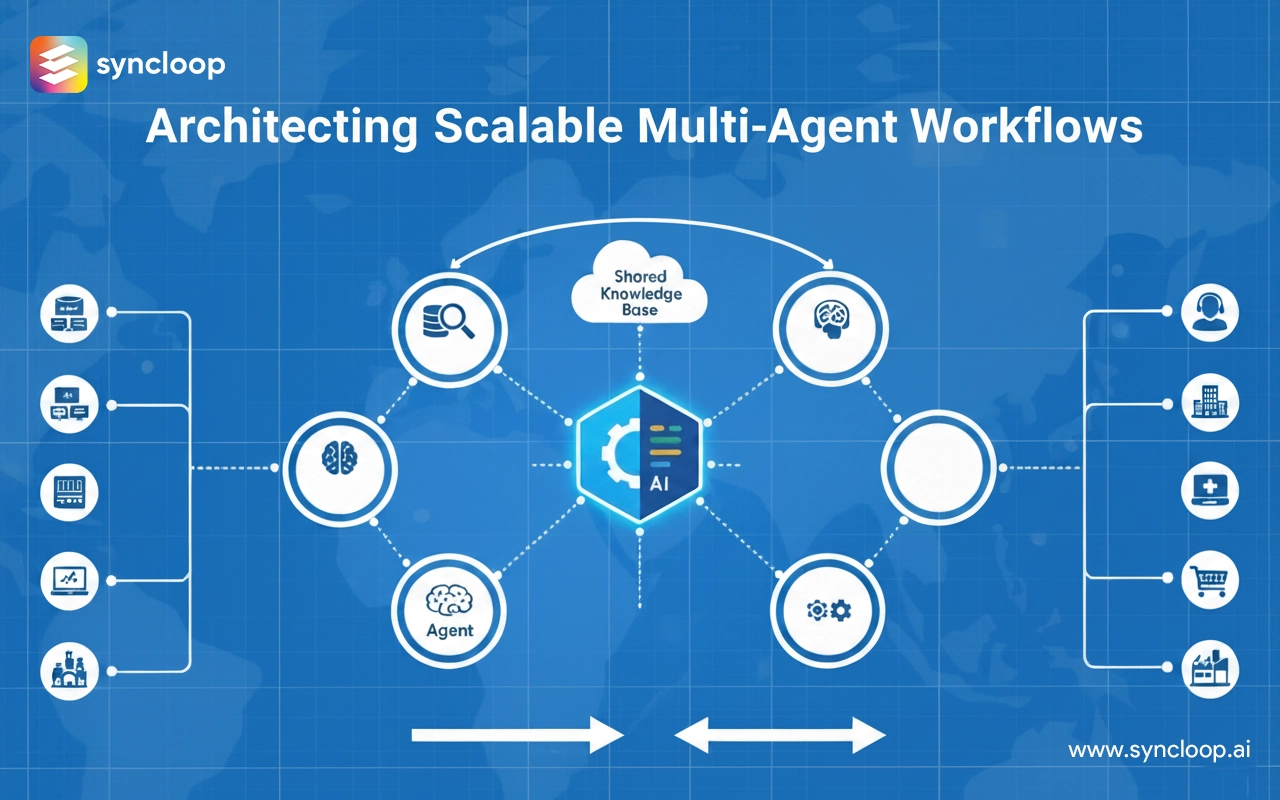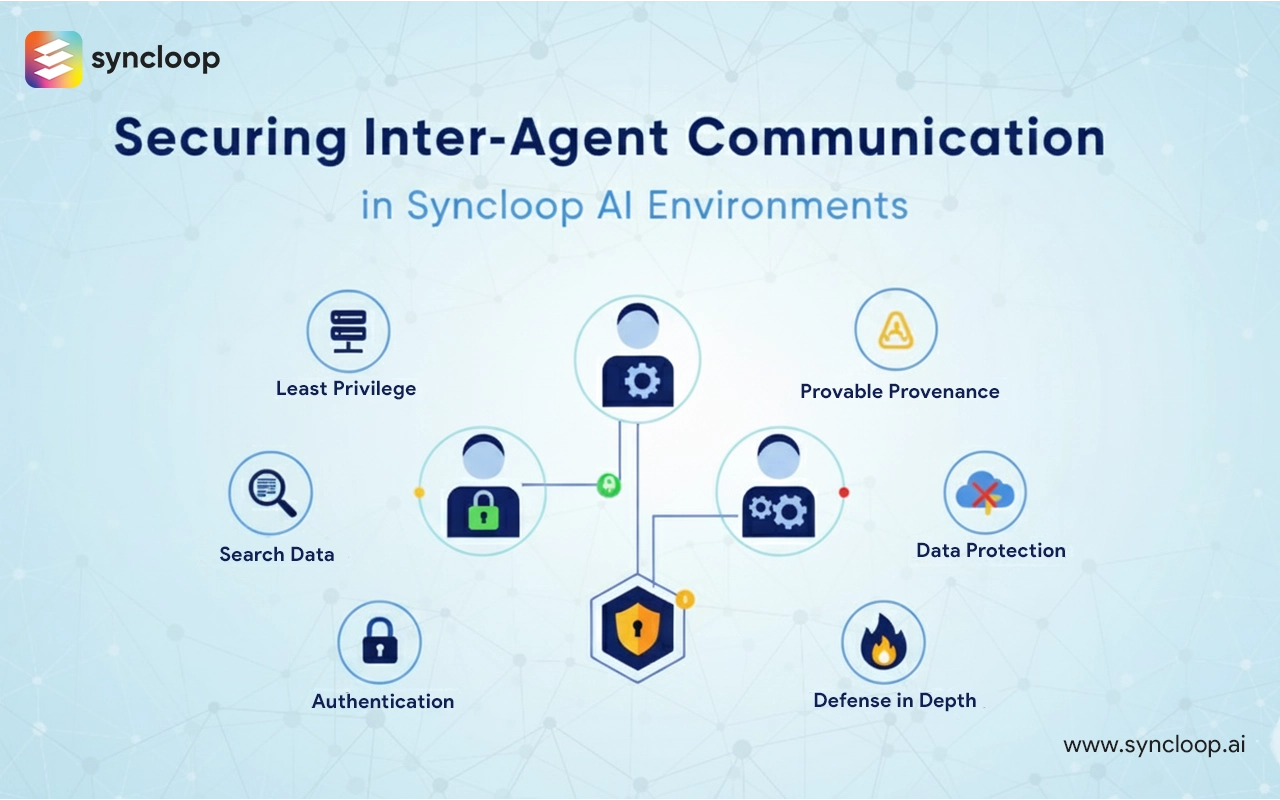Understanding the Syncloop AI Multi-Agent Framework
Posted by: David Miller | October 29, 2025

In today’s rapidly evolving digital landscape, organizations across industries are reimagining how work gets done. The demand for speed, accuracy, and continuous adaptability has surpassed the capabilities of traditional automation systems. Businesses are now turning toward intelligent, self-coordinating ecosystems that can sense, reason, and act autonomously. This shift marks the dawn of a new era —the era of Intelligent Automation, and at the center of it stands Syncloop AI, a revolutionary platform built on the foundation of multi-agent intelligence.
Syncloop AI redefines automation by moving beyond the conventional “rule-based” models to a world where multiple intelligent agents interact through APIs, share contextual knowledge, and make dynamic decisions —all within an orchestrated framework. This human-inspired intelligence allows organizations to create adaptive workflows that think, collaborate, and evolve.
This blog explores how Syncloop AI powers the future of intelligent automation, its transformative impact across industries, and why businesses adopting it today are setting the stage for tomorrow’s autonomous enterprises.
The Evolution from Automation to Intelligence
For decades, automation has been about replacing repetitive tasks. Robotic Process Automation (RPA) tools simplified workflows, but they lacked contextual understanding. They could follow rules, but not reason. They could execute instructions, but not learn from outcomes.
Syncloop AI introduces a major paradigm shift. It blends automation with cognitive intelligence through multi-agent collaboration. Instead of relying on a single, monolithic system, Syncloop AI deploys multiple specialized agents —each with distinct skills —that work together through well-defined APIs and shared knowledge bases.
These agents communicate in real time, retrieving information, generating insights, verifying data, and adapting to dynamic conditions. This model allows automation to move from simple execution to strategic reasoning —transforming static workflows into living, learning systems.
Understanding the Syncloop AI Multi-Agent Framework
At the core of Syncloop AI lies a multi-agent frameworkdesigned to mirror how humans collaborate in teams. Each agent within Syncloop AI performs a specialized role, but when connected, they form an ecosystem that can handle complex, cross-functional operations.
Here’s how it works:
- Autonomous Agents: Each agent operates independently yet cooperatively, equipped with its own goal, reasoning model, and access to shared knowledge
- API-Orchestrated Collaboration: Agents communicate via APIs, ensuring seamless integration across systems, tools, and data sources.
- Contextual Intelligence: Through Retrieval-Augmented Generation (RAG) and knowledge bases, agents understand the context of queries and deliver fact-based, accurate responses.
- Continuous Learning: Agents evolve through feedback, learning from each task or interaction to enhance future performance.
This architecture makes Syncloop AI not just a tool but an intelligent ecosystem capable of self-adaptation, making it ideal for dynamic environments like finance, healthcare, logistics, and enterprise automation.
Why Multi-Agent Systems Are the Future of Intelligent Automation
Traditional automation follows linear logic —input leads to output. Multi-agent systems, like those in Syncloop AI, operate on networked intelligence. Each agent doesn’t just execute; it reasons, collaborates, and shares insights with others.
This distributed intelligence enables:
- Parallel Decision-Making: Multiple agents can process and analyze data simultaneously, significantly reducing latency in decision cycles.
- Scalability: New agents can be added to handle emerging business functions without disrupting existing workflows.
- Resilience: The system continues to function even if one agent fails, as others can adapt and reroute tasks.
- Continuous Adaptation: Agents learn from changing environments, ensuring automation remains relevant over time
Such capabilities are redefining what enterprises can achieve with automation. Businesses no longer have to choose between speed and intelligence —Syncloop AI delivers both.
Syncloop AI in Action: Transforming Workflows Across Industries
The true power of Syncloop AI becomes evident when applied to real-world scenarios. Across diverse industries, multi-agent systems are changing the way enterprises operate
- Financial Services: Fraud detection, KYC verification, and transaction monitoring can be handled by specialized agents that analyze, cross-verify, and flag anomalies in real time, ensuring regulatory compliance while reducing manual intervention.
- Healthcare: Agents can coordinate patient data retrieval, treatment recommendations, and report generation, improving accuracy and reducing administrative burden for medical professionals.
- E-commerce and Retail: Syncloop AI agents can personalize customer experiences, manage inventory levels, predict trends, and even automate supplier coordination.
- Logistics and Supply Chain: AIntelligent routing agents optimize delivery routes while procurement agents handle vendor negotiations —all autonomously yet harmoniously.
- Human Resources: From recruitment screening to onboarding, agents automate repetitive HR functions while preserving the human touch through contextual understanding.
In every use case, the hallmark of Syncloop AI remains its ability to create orchestrated intelligence—where every agent contributes toward a shared outcome with minimal human oversight
Seamless API-Driven Integration: The Syncloop Advantage
Integration is one of the biggest challenges in enterprise automation. Disconnected systems and fragmented data often lead to inefficiencies. Syncloop AI addresses this by placing APIs at the heart of its multi-agent ecosystem.
Every agent communicates via secure, standardized APIs, enabling interoperability across platforms, databases, and external tools. Whether connecting to CRMs, ERP systems, data lakes, or external AI services, Syncloop ensures all interactions are consistent, traceable, and scalable.
This API-first approach allows businesses to integrate new tools effortlessly, extend functionality, and adapt quickly to evolving requirements —without rebuilding their automation stack
Empowering Human Teams with Intelligent Collaboration
Contrary to the misconception that automation replaces humans, Syncloop AI enhances human potential. By delegating repetitive and data-heavy tasks to intelligent agents, organizations allow human employees to focus on creativity, problem-solving, and strategic thinking
Agents can act as digital collaborators, providing insights, summaries, or predictive analytics to human teams in real time. For example, in customer support, one agent can summarize prior conversations while another drafts personalized responses —enabling faster and more empathetic service
This human-in-the-loop model ensures that automation remains aligned with human goals and ethical considerations, fostering a balance between machine precision and human judgment.
The Role of Knowledge Bases in Intelligent Automation
Syncloop AI integrates knowledge basesas the foundation for informed agent reasoning. Knowledge bases act as trusted repositories of structured information, allowing agents to reference facts, policies, and domain data beforemaking decisions.
This approach minimizes hallucinations —a common challenge in traditional AI models —and ensures that every output is grounded in verified data. With dynamic knowledge retrieval mechanisms, Syncloop AI agents can access the most relevant information instantly, ensuring reliability and transparency across operations.
Syncloop AI and the Path Toward Autonomous Enterprises
Imagine a future where businesses run as interconnected ecosystems of intelligent agents —each capable of sensing change, reasoning autonomously, and acting in coordination with others. That is the vision of Syncloop AI.
As organizations adopt Syncloop AI, they move closer to creating autonomous enterprises—self-optimizing entities that can manage processes, respond to disruptions, and drive innovation independently.
These enterprises are no longer reactive; they are proactive, predictive, and self-evolving. Syncloop AI’s multi-agent infrastructure is the foundation on which this future is being built —a future whereintelligence is not centralized but distributed, dynamic, and deeply collaborative.
Businesses are choosing Syncloop AI because it delivers:
- Flexibility: Modular design allows enterprises to build agents suited to specific business processes.
- Speed: Parallel processing enables rapid execution of complex workflows
- Accuracy: Fact-based RAG and knowledge base integration reduce errors.
- Security: API governance ensures safe and auditable communication between agents.
- Scalability: New agents and capabilities can be added without major architectural changes.
In short, Syncloop AI doesn’t just automate; it orchestrates intelligenceacross every corner of the enterprise.
Conclusion
The future of automation is not about replacing people —it’s about empowering them with intelligence that scales. Syncloop AI embodies this vision through its multi-agent architecture, blending cognitive reasoning, contextual understanding, and seamless integration into one cohesive platform
With Syncloop AI, businesses can unlock a new era of autonomous collaboration, where machines and humans work side by side, driving unprecedented efficiency and innovation. The path to intelligentautomation is here, and Syncloop AI is lighting the way forward
Back to Blogs







